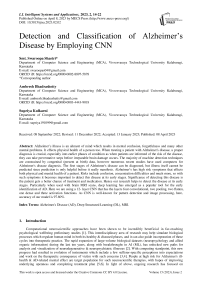Detection and Classification of Alzheimer’s Disease by Employing CNN
Автор: Smt. Swaroopa Shastri, Ambresh Bhadrashetty, Supriya Kulkarni
Журнал: International Journal of Intelligent Systems and Applications @ijisa
Статья в выпуске: 2 vol.15, 2023 года.
Бесплатный доступ
Alzheimer’s illness is an ailment of mind which results in mental confusion, forgetfulness and many other mental problems. It effects physical health of a person too. When treating a patient with Alzheimer's disease, a proper diagnosis is crucial, especially into earlier phases of condition as when patients are informed of the risk of the disease, they can take preventative steps before irreparable brain damage occurs. The majority of machine detection techniques are constrained by congenital (present at birth) data, however numerous recent studies have used computers for Alzheimer's disease diagnosis. The first stages of Alzheimer's disease can be diagnosed, but illness itself cannot be predicted since prediction is only helpful before it really manifests. Alzheimer’s has high risk symptoms that effects both physical and mental health of a patient. Risks include confusion, concentration difficulties and much more, so with such symptoms it becomes important to detect this disease at its early stages. Significance of detecting this disease is the patient gets a better chance of treatment and medication. Hence our research helps to detect the disease at its early stages. Particularly when used with brain MRI scans, deep learning has emerged as a popular tool for the early identification of AD. Here we are using a 12- layer CNN that has the layers four convolutional, two pooling, two flatten, one dense and three activation functions. As CNN is well-known for pattern detection and image processing, here, accuracy of our model is 97.80%.
Alzheimer's Disease (AD), Deep Structured Learning (DL), MRI
Короткий адрес: https://sciup.org/15018989
IDR: 15018989 | DOI: 10.5815/ijisa.2023.02.02
Список литературы Detection and Classification of Alzheimer’s Disease by Employing CNN
- E. Bullmore and O. Sporns, "Complex mind organizations: Graph hypothetical examination of primary and utilitarian frameworks," Nature surveys. Neuroscience, vol. 10, pp. 186-98, 03 2009.
- S. Eickhoff, T. E. Nichols, J. D. V. Horn, and J. A. Turner, "Sharing the abundance: Neuroimaging information stores," NeuroImage, vol. 124, pp. 1065 - 1068, 2016.
- A. Chaddad, C. Desrosiers, and T. Niazi, "Profound radiomic investigation of x-ray connected with alzheimer's infection," IEEE Access, vol. 6, pp. 58213-58221, 2018.
- Weiming Lin, Tong Tong, Qinquan Gao, Di Guo, Xiaofeng Du, Yonggui Yang, Gang Guo, Min Xiao, Min Du, Xiaobo Qu, Alzheimer’s Disease Neuroimaging Initiative, “Convolutional Neural Networks-Based MRI Image Analysis for the Alzheimer's Disease Prediction from Mild Cognitive Impairment”, 2018 Nov 5;12:777. doi: 10.3389/fnins.2018.00777. eCollection 2018.
- S. Ahmed, K. Y. Choi, J. J. Lee, B. C. Kim, G.- R. Kwon, K. H. Lee, and H. Y. Jung, "Troupes of fix based classifiers for determination of alzheimer illnesses," IEEE Access, vol. 7, pp. 73373-73383, 2019.
- L. Zou, J. Zheng, C. Miao, M. J. Mckeown and Z. J. Wang, ”3D CNN Based Automatic Diagnosis of Attention Deficit Hyperactivity Disorder Using Functional and Structural MRI,” in IEEE Access, vol. 5, pp. 23626- 23636, 2017.
- L. Keuck, “History as a biomedical matter: recentre assessments of the first cases of alzheimer’s disease,” History and Philosophy of the Life Sciences, vol. 40, no. 1, p. 10, 2017.
- K. Trojachanec, I. Kitanovski, I. Dimitrovski, and S. Loshkovska, “Longitudinal brain mri retrieval for alzheimer’s disease using different temporal information,” IEEE Access, vol. 6, pp. 9703–9712, 2017.
- M. Hon and N. M. Khan, “Towards Alzheimer’s disease classification through transfer learning,” in Proc. IEEE International Conference on Bioinformatics and Biomedicine (BIBM), Kansas City, pp. 1166-1169, 2017.
- E. R. Adlard, “Richard j. sundberg: The chemical century. molecular manipulation and its impact on the 20th century,” Chromatographia, vol. 80, no. 10, pp. 1599–1599, 2017.
- Swaroopa Shastri, A Patange “ International Journal of Engineering Science “ vol.7,Issue 7,Pp.14272-14275, 2017
- N. Bhagwat, "Prognostic applications for alzheimer's sickness utilizing attractive reverberation imaging and AI," Ph.D. exposition, Graduate Department of Institute of Biomaterials and Biomedical Engineering University of Toronto, 2018.
- J. Yao, "Improvement of a multimodal system for cardiovascular figured tomographygating,"Ph.D.dissertation,SchoolofElectricalandComputer Engineering, Georgia Institute of Technology, 2018.
- N. Hill and J. Mogle, “Alzheimer’s disease risk factors as mediators of subjective memory impairment and objective memory decline: protocol for a construct-level replication analysis,” BMC Geriatrics, vol. 18, 2018.
- K. F. Tracker, M. Northwood, V. Haggar, and F. Bates, Management of Fecal Incontinence in Frail Older Adults Living in the Community. Springer International Publishing, 2018, pp. 127-148.
- R. H. Blank, End-of-Life Decision Making for Alzheimer’s Disease Across Cultures. Springer Singapore, 2019, pp. 121–136.
- D. Jin, J. Xu, K. Zhao, F. Hu, Z. Yang, B. Liu, T. Jiang, and Y. Liu, “Attention-based 3d convolutional network for alzheimer’s disease diagnosis and biomarkers exploration,” in 2019 IEEE 16th International Symposiumon BiomedicalImaging (ISBI2019). IEEE, 2019, pp.1047– 1051.
- J.- Y. Han, L. Besser, C. Xiong, W. Kukull, and J. Morris, "Cholinesterase inhibitors may not benefit gentle mental hindrance and gentle alzheimer diseasedementia,"Alzheimerdiseaseandassociateddisorders, vol.33, pp. 87-94, 04 2019.
- I. Vatanabe, P. Manzine, and M. Cominetti, “Historicconceptsofdementia and alzheimer’s disease: From ancient times to the present,” Revue Neurologique, 2019.
- Emtiaz Hussain‡, Mahmudul Hasan, Syed Zafrul Hassan, Tanzina Hassan Azmi, Md Anisur Rahman, Mohammad Zavid Parvez, “Deep Learning Based Binary Classification of Alzhiemer’s Disease Detection using Brain MRI Images”, 978-1-7281-5169- 4/20/$31.00 c 2020 IEEE.
- Raigonda, M. R., Terdal, S. P., & Raigond, B. (2022). Detection of the viral disease on the potato foliar and tubers using a machine learning approach. International Journal of Health Sciences, 6(S4), 9336–9354. https://doi.org/10.53730/ijhs.v6nS4.10740.
- Rani, Megha & Terdal, Sujatha. (2022). Design Engineering A Review on the Disease Identification on the Potato Foliar and Tuber.


